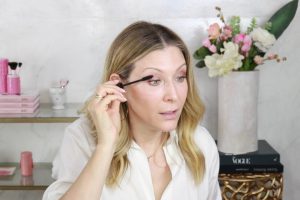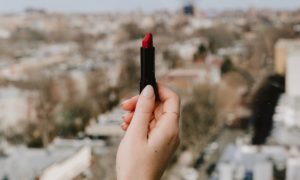If there’s one ingredient that everyone can agree is a good one, it’s retinoids. Retinoids (which include the better known retinol) have the stamp of approval from dermatologists, cosmetic chemists, and aestheticians alike — because they’re that good. They can do it all, from clearing breakouts to minimizing the look of fine lines and wrinkles.
With that in mind, we had to ask: Why isn’t everyone using retinoids right now? NakedPoppy skin specialist Tara Parenti has heard it all: Some people don’t quite understand how it can benefit their skin, while others don’t want to deal with an extra step in their skincare routine. “Some have even tried a retinol, but experienced unpleasant and uncomfortable side effects from using it and are nervous to try it again,” she says. “And some simply don’t know how to approach it — for instance, what derivative?”
And hey, we get it. With many active ingredients but especially when it comes to retinoids, things can seem tricky fast. That’s why this guide breaks down everything you need to know about this wonder ingredient — and how you can introduce it into your routine for your most glowing, firmest skin yet.
What are retinoids?
While we won’t give you a pop quiz on this, it helps to have some context on the terms out there — since it’s common to see “retinoids” and “retinol” used interchangeably. “Retinoids describe all forms of vitamin A,” says NakedPoppy research scientist Marisa Plescia. “Retinoid family includes retinol and its other natural derivatives, like retinoic acid, retinaldehyde, and retinyl esters like retinyl palmitate, plus many other synthetic derivatives.”
While you can find all of the above in many beauty products, the most important to remember is retinol, since it tends to be the best known of the many retinoids out there.
The benefits of retinoids
So, why use a retinoid? Easy: “Retinoids work,” says Plescia. “The effects of retinoids are known to influence many cellular processes and have been studied for decades as an efficacious skincare ingredient.”
Since they have a hand in so many biological processes, they can improve skin on multiple fronts — making them the ultimate multitasker on your shelf. For instance, “retinoids can help diminish lines and wrinkles by stimulating collagen production; promote cell turnover and proliferation to help unclog pores; and prevent the transfer of melanosomes to fade hyperpigmentation,” says Parenti. In targeting multiple concerns in one go, it can often be all you need for healthier, more radiant skin.
How to start using a retinoid
Retinoids aren’t as simple to slot into your routine as, say, a cleanser or moisturizer. Since they work on skin’s cellular level, their side effects can be a little gnarly, as we’ll get into below. That’s why a 101 for newbies is helpful — as are some pro-tips for avoiding any drawbacks.
Choose your retinol
There are many kinds of retinoids to choose from. Most of them go through various conversions in the skin to turn into retinoic acid, which is the potent, active form that gets stuff done. “Retinoic acid is otherwise known as tretinoin or as the brand name Retin-A in prescription-only products, prescribed by — most often — a dermatologist,” says Plescia.
Since retinoic acid can be too much, too fast for many people, she recommends starting with retinol, which converts to retinoic acid; this conversion process acts like kind of a speedbump, slowing its impact. That said, you won’t be skimping on results. “Studies have found retinol significantly affects the cellular properties of the skin with similar effectiveness to retinoic acid — but with much less skin irritancy and redness,” she says. [1]
For newbies and skincare obsessives alike, consider our NakedPoppy Renew Retinol Oil. Not only is it powered by a clean retinol, which we’ve encapsulated in naturally derived liposomes, but it’s also paired with bakuchiol (a botanical that works similarly to retinol) to enhance results. Plus, the encapsulation works double-duty: It both encourages effective delivery into skin and allows for a slower release of retinol — keeping it gentle.
Go slow and steady
Got your retinol in hand? When you’re just starting out, less is more — we’re talking one to two times a week, max (if you’re using our Renew Retinol Oil, though, you can start at two times a week). “It can take a few weeks for your skin to get used to retinoids, and then allow for less discomfort and more daily use,” says Plescia.
That’s because retinoids require retinization, a.k.a. the term used to describe the adjustment period during which skin adapts to the use of topical retinoids. During this time, “you may experience dry, irritated skin with peeling, scaling, redness, or a burning or stinging sensation,” she adds. After two or three weeks without any of the above symptoms, you can add in an extra night — then ramp it up from there.
Pair it wisely
Now is not the time to experiment with exfoliation. “For newbies — or until you learn how your skin will tolerate and respond to retinol — alternate its usage with chemical exfoliating ingredients, such as alpha hydroxy acids,” Parenti says. (Although if you’re working with a damaged skin barrier, suspend it altogether!) You might also want to steer clear of potentially irritating ingredients, such as vitamin C and those found in acne products. These can make it tough to gauge how your skin is handling the retinoid, and could potentially worsen the retinization process.
What you should slather on with abandon, however, is sunscreen. “Wearing SPF is also always a must — not only for sun safety, but because if you get sunburnt, that is only going to make the redness, inflammation, and irritation and discomfort feel worse,” Plescia says.
If you’re starting with a retinoid and want to complete the rest of your routine, you’re in luck: Take our quick, 3-minute beauty assessment for recommendations tailored to your skincare goals and concerns.
Bring on the moisturizer
Moisturizer is retinoid’s BFF. While your skin is adjusting to it — and all the time, really — “the skin barrier needs to remain as healthy as possible,” says Plescia. “Reinforcing the skin with plant-based oils can help nourish, moisturize, and soothe the skin, helping to minimize any irritation that can be typical of retinol.” Not only do they replenish moisture to skin, but they can reduce the dryness, inflammation, and itchiness caused by retinol — making it easier to tolerate.
To that end, you can find squalene and bisabolol (as well as rosehip seed and argan oils) in the Renew Retinol Oil, where they actively soothe and calm skin. That way, you can reap all the benefits of retinoids without compromising your overall skin health — giving you the best of both worlds.
Get “shockingly accurate” clean beauty picks. Take your beauty assessment.
Shop the Story:
References
[1] studies have found retinol significantly affects the cellular properties of the skin with similar effectiveness to retinoic acid — but with much less skin irritancy and redness






Comments